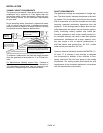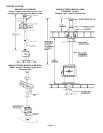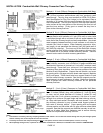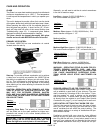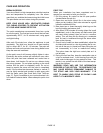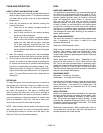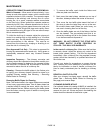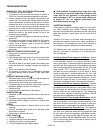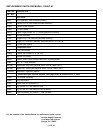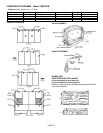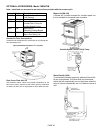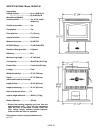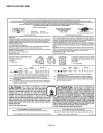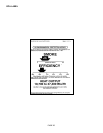MAINTENANCE
PAGE 18
CREOSOTE FORMATION AND NEED FOR REMOVAL
What is Creosote - When wood is burned slowly, it pro-
duces tar and other organic vapors, which combine with
expelled moisture to form creosote. The creosote vapors
condense in the relatively cool chimney flue of a slow-
burning fire. As a result, creosote residue accumulates
on the flue lining. When ignited this creosote makes an
extremely hot fire. Also, creosote deposits tend to form in
long runs of venting where gases become too cool prior
to exhausting. Note: Single wall pipe cools rapidly, there-
fore installations using this type of flue are more suscep-
tible to creosote deposits.
To inhibit the build up of creosote, adjust the primary air
control to a medium-high or high setting for a 10-minute
period each day. Do not attempt to burn out heavy creo-
sote accumulations in this manner. This must be re-
moved from the chimney by scraping or brushing to re-
duce the risk of a chimney fire.
Burn Approved Fuel Only - This stove is approved for
burning dry seasoned natural wood only. Using green or
inadequately seasoned wood may increase creosote
buildup.
Inspection Frequency - The chimney connector and
chimney should be inspected at least twice monthly dur-
ing the heating season to determine if a creosote buildup
has occurred. If creosote has accumulated it should be
removed to reduce the risk of a chimney fire.
Cleaning - Remove the baffle plates in the firebox prior
to having your chimney cleaned (should be done by a
qualified chimney sweep). See following – Removing
Baffle Plates for Cleaning).
Removing Baffle Plates for Cleaning
Note: The smoke baffle in the upper firebox area consists
of two heavy gage steel plates. One of these plates has
a welded strap to overlap the seam, which runs front to
back between the two. Before removing the baffle plates
from the firebox, wearing a pair of leather or work gloves
is recommended.
1. To remove the baffle, reach inside the firebox and
slide one plate over the other.
2. Next move the metal plates, stacked one on top of
the other, sideways toward the center of the stove.
3. Then move the two baffle plate toward the front of
the stove to clear the ledge they rest on at the rear.
Be mindful these metal plates are quite heavy, so
use care in lowering them out of the way.
4. Once the baffle plates are out of the firebox, the flue
can be cleaned. The accumulated soot that is re-
moved by brushing will fall to the firebox floor where
it can be removed and disposed of.
WARNING! DO NOT OPERATE THE STOVE WITH-
OUT THESE BAFFLE PLATES PROPERLY IN-
STALLED. THIS WILL VOID WARRANTY.
In the event of a chimney fire - Make sure the fuel door
is securely closed. Adjust the primary air control to the
lowest (most closed) setting. Call the fire department
immediately. After a chimney fire, the complete chimney
system should be checked by a qualified technician be-
fore further use.
Consult your dealer for suggestions on proper chimney
care. Contact your local municipal or provincial fire au-
thority for information on how to handle a chimney fire.
Have a clearly understood plan for handling a chimney
fire.
REINSTALL BAFFLE PLATES
After your chimney has been swept, reinstall the baffle
plates. See – Removing Baffle Plates for Cleaning (on
this page) and reverse steps.
CLEANING BLOWER INTAKE
If an optional blower kit (catalog #14M22) is installed, the
blower air intake requires cleaning at least once a year to
remove lint, dust, etc. If there are pets in the dwelling, the
intake should be cleaned at least twice a year.



